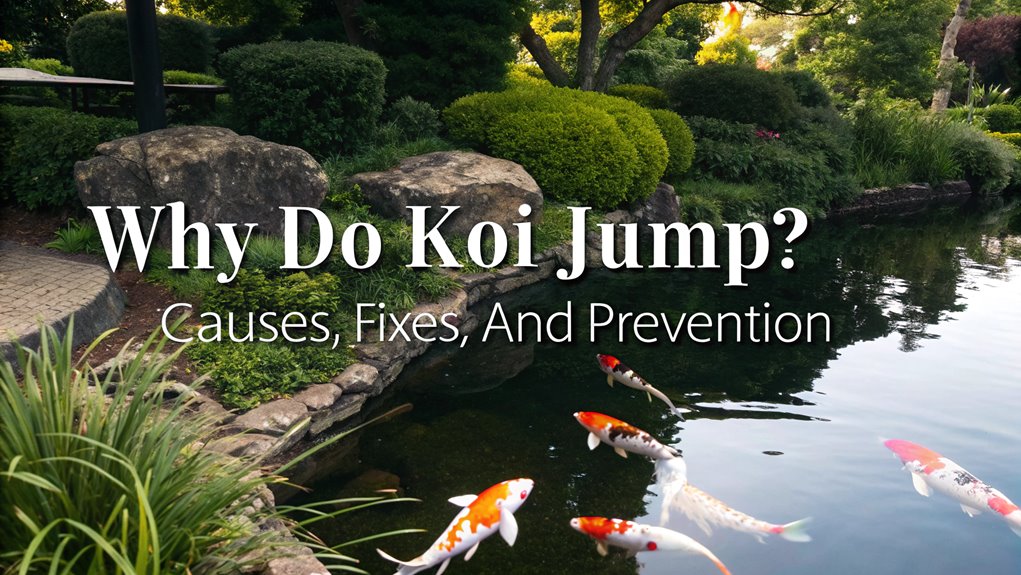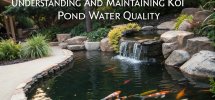Koi jump primarily due to stressors like poor water quality, low oxygen levels, overcrowding, or environmental disturbances. Ensure you’re testing water regularly for ammonia, nitrate, and pH, maintaining levels that support koi health. Upgrading filtration and aeration systems can boost oxygenation, while adequate space reduces competition and aggression. Secure netting prevents jumping mishaps. Observing behavior helps detect distress, prompting proactive interventions. Explore further to uncover in-depth strategies and examples to enhance your koi’s well-being.
Key Facts Summarized
- Koi jump due to poor water quality, including high ammonia and low oxygen levels.
- Overcrowding and competition for resources can lead to increased jumping behavior in koi.
- Environmental disturbances such as loud noises or predators can trigger koi to jump.
- Regular water testing and maintenance improve quality and reduce stress-induced jumping.
- Providing adequate space and secure netting helps prevent koi from jumping out of the pond.
Understanding the Reasons Behind Koi Jumping
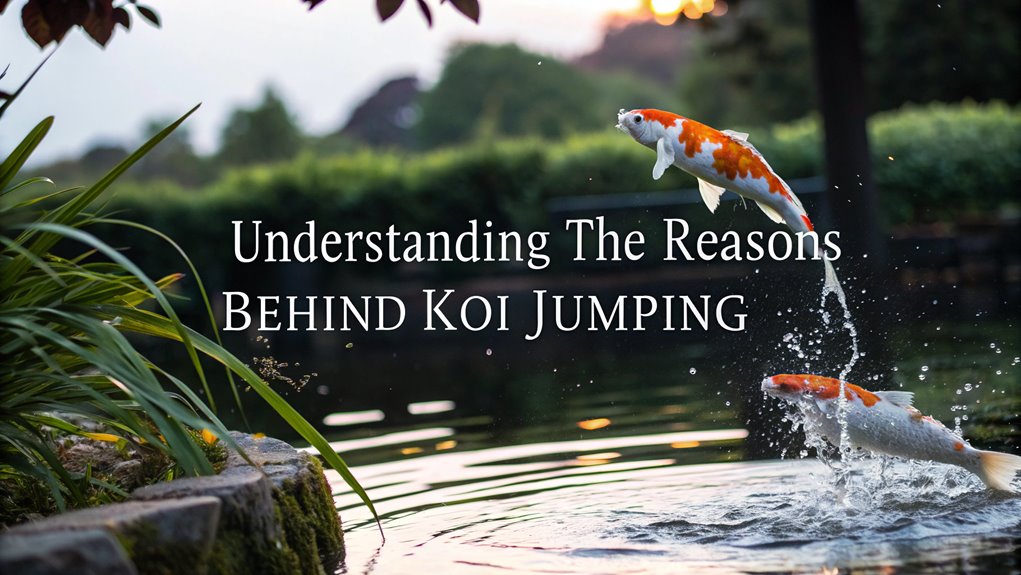
Although koi jumping may seem like a whimsical spectacle, understanding the underlying reasons is crucial for maintaining their well-being. Koi exhibit jumping behavior due to factors like poor water quality and insufficient oxygen levels. High ammonia or nitrate levels in a new pond can distress koi, prompting jumps as a survival mechanism.
Ensuring proper pond maintenance, including regular water quality checks, is vital. Additionally, inadequate space can lead to stress in koi, causing them to jump from overcrowding. Ensure your pond provides adequate space and is well-aerated to facilitate oxygen circulation.
Regularly assess and adjust these elements, as they play a role in minimizing stress-induced jumping. By addressing these factors, you’ll improve your koi’s environment and reduce unnecessary jumping behavior. Maintaining adequate oxygen levels is essential, especially for larger koi, to prevent distress that could lead to jumping.
Common Environmental Stressors for Koi
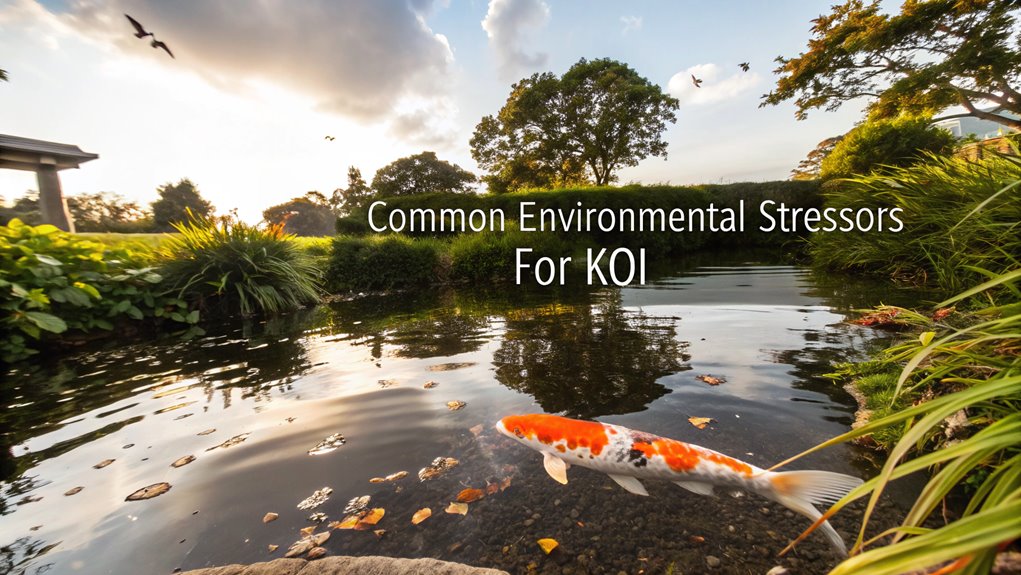
When maintaining a healthy koi pond, understanding common environmental stressors is key to preventing behavioral issues like jumping. High ammonia levels in the water can stress koi, prompting them to jump as an escape response. Regular water tests help identify and mitigate such issues.
Insufficient oxygen in the water is another stressor, often leading koi to surface for air and consequently jump. Ensure adequate aeration and water movement.
Overcrowding in the pond increases resource competition, causing aggression and erratic jumping.
Environmental disturbances like loud noises or predators can trigger koi to leap out of the water, a survival instinct.
Seasonal changes, including temperature fluctuations and algae blooms, also contribute to discomfort, increasing the likelihood of koi jumping. During spring maintenance, it’s essential to prepare the pond environment to reduce stressors and promote healthy behaviors in your koi.
Identifying and Improving Water Quality
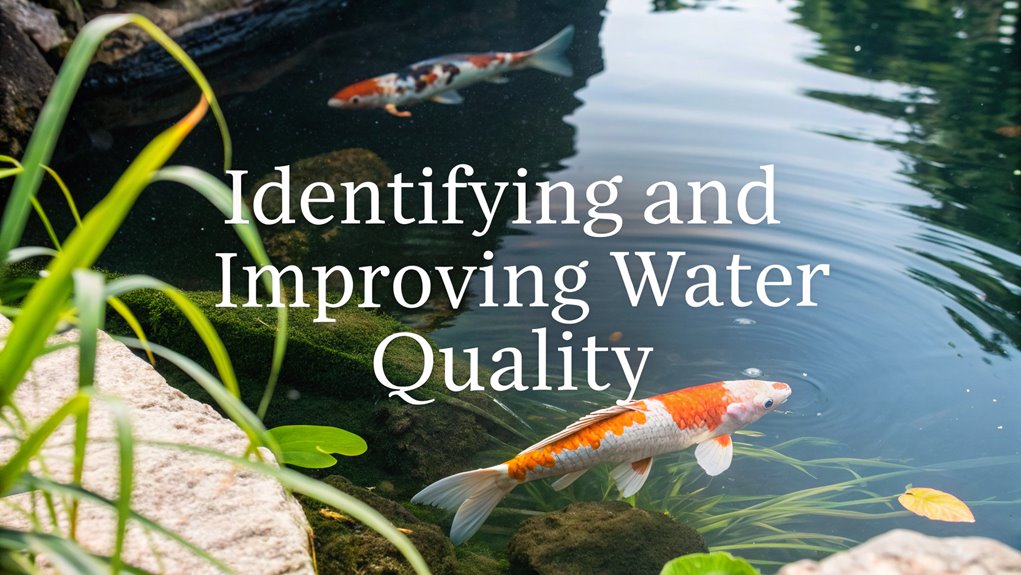
To ensure a thriving koi pond, prioritize identifying and improving water quality through systematic monitoring and intervention.
Regularly test the water for ammonia, nitrate, and pH levels. High ammonia, exceeding 0.5 ppm, damages gills, causing koi fish to become stressed and exhibit jumping behavior.
Maintain optimal pH levels between 6.5 and 8.5 to prevent erratic movements. Implement an effective filtration system and aeration methods to sustain oxygen levels between 3 ppm and 10 ppm, promoting a healthy environment.
Regular water changes mitigate toxic buildup, which can cause koi distress. By controlling algae growth, you prevent imbalances in the ecosystem. Additionally, introducing beneficial bacteria can help break down organic waste and reduce nutrient levels, further enhancing water quality.
Through these measures, you’ll improve water quality and reduce stress-induced jumping in your koi fish.
Strategies to Prevent Koi From Jumping
Ensuring koi remain safely within the confines of their pond requires a strategic approach to their environment.
Start by providing enough space; overcrowding can induce stress, causing koi to jump. Follow the guideline of one 6-inch koi per hundred gallons.
Regular water testing with a test kit is essential to maintain optimal conditions, as poor quality can signal something is wrong.
New fish introductions should be handled with care; quarantine them before adding to prevent disease transmission.
Utilize pond services to enhance water aeration through features like waterfalls. This keeps the water oxygenated, promoting normal behavior.
Secure netting can deter jumping and protect from predators. Adequate hiding spots also reduce stress, offering a secure refuge for your koi. Additionally, overstocking is a common issue among new koi pond owners and can lead to increased stress levels.
Monitoring Koi Behavior for Signs of Distress
Observing koi behavior offers critical insights into their well-being and can help identify potential issues before they escalate. Regular observation reveals signs of distress such as increased jumping or lethargy. These behaviors often indicate environmental problems, possibly linked to water quality or unstable conditions. Monitoring key parameters like pH and ammonia levels ensures a healthy habitat. Additionally, changes in behavior may also suggest issues with aquatic veterinary care, highlighting the importance of regular health assessments.
| Observation | Possible Cause |
|---|---|
| Increased Jumping | Aggression or Bullying |
| Lethargy | Poor Water Quality |
| Bottom Dwelling | Temperature Fluctuations |
| Erratic Feeding | Environmental Stressors |
Pay attention to koi behavior during feeding times to discern if jumping stems from hunger or stress. Ensure adequate space to reduce aggression, and maintain stable conditions to prevent sudden stress responses, promoting overall koi well-being.
Frequently Asked Questions
How to Prevent Koi From Jumping?
Ensure koi don’t jump by maintaining optimal water quality, reducing overcrowding, and providing hiding spots. Install netting for protection and increase aeration with pumps. Regularly test water for ammonia and nitrates to address discomfort.
Why Do Koi Jump?
You observe koi jumping due to environmental exploration or distress from poor water quality. Analyze water parameters; high ammonia, nitrates, or low oxygen levels can cause stress. Address these issues to maintain a stable, healthy habitat.
How Do Koi Fish Protect Themselves?
You’ll notice koi fish employ subtle tactics like “taking the leap” when they sense unease. They instinctively navigate to deeper waters or seek sanctuary in rocks and plants, using natural camouflage as a frontline defense against predators.
How Do You Know if a Koi Fish Is Happy?
You can tell a koi is happy when it’s active and vibrant, showing bright colors and clear scales. It eagerly interacts with you during feeding, and socializes with others, indicating a healthy, balanced environment.
Conclusion
In understanding koi jumping, it’s crucial to monitor water quality and environmental stressors. For instance, if you notice your koi frequently leaping, test the water for ammonia levels; high concentrations can cause distress. By addressing these issues and creating a stable habitat, you can prevent jumping. Regularly observe your koi for unusual behavior, as early detection of stress indicators can lead to timely interventions, ensuring your pond remains a safe and harmonious environment for your koi.
